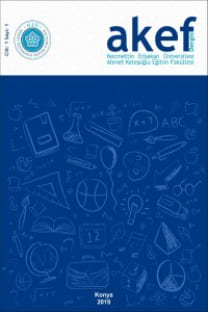Eğitimde Chatbot Kullanmaya ve Öğrenmeye Yönelik Davranışsal Niyet Ölçeğinin Türkçeye Uyarlanması
UTAUT2, Chatbot, Davranışsal niyet, Chatbot kullanma ve öğrenme, Üniversite öğrencileri.
Adaptation of Behavioral Intention to Use and Learn Chatbot in Education Scale into Turkish
UTAUT2, Chatbot, Behavioural intention, Use and learn chatbot, University students.,
___
- Brown, T. A. (2006). Confirmatory Factor Analysis for Applied Research. (First Edition). NY: Guilford Publications, Inc.
- Fryer, L. K., Thompson, A., Nakao, K., Howarth, M., & Gallacher, A. (2020). Supporting self-efficacy beliefs and interest as educational inputs and outcomes: Framing AI and Human partnered task experiences. Learning and Individual Differences, 80, 101850.
- Gefen, D., Straub, D., & Boudreau, M. C. (2000). Structural equation modeling and regression: Guidelines for research practice. Communications of the association for information systems, 4(1), 7.
- Hu, L. T., & Bentler, P. M. (1999). Cutoff criteria for fit indexes in covariance structure analysis: Conventional criteria versus new alternatives. Structural Equation Modeling: A Multidisciplinary Journal, 6(1), 1-55.
- Iku-Silan, A., Hwang, G. J., & Chen, C. H. (2023). Decision-guided chatbots and cognitive styles in interdisciplinary learning. Computers & Education, 201, 104812.
- Jöreskog, K. G. & Sörbom, D. (1993). LISREL 8: Structural Eguation Modeling with the Simplis Command Language. USA: Scientific Software ınternational, Inc.
- Kim, J. W., Jo, H. I., & Lee, B. G. (2019). The study on the factors influencing on the behavioral intention of chatbot service for the financial sector: Focusing on the UTAUT model. Journal of Digital Contents Society, 20(1), 41-50.
- Koh, J. H. L., & Kan, R. Y. P. (2021). Students’ use of learning management systems and desired e-learning experiences: Are they ready for next generation digital learning environments?. Higher Education Research & Development, 40(5), 995-1010.
- Mateos-Sanchez, M., Melo, A. C., Blanco, L. S., & García, A. M. F. (2022). Chatbot, as educational and inclusive tool for people with intellectual disabilities. Sustainability, 14(3), 1520.
- Mokmin, N. A. M., & Ibrahim, N. A. (2021). The evaluation of chatbot as a tool for health literacy education among undergraduate students. Education and Information Technologies, 26(5), 6033-6049.
- Raffaghelli, J. E., Rodríguez, M. E., Guerrero-Roldán, A. E., & Baneres, D. (2022). Applying the UTAUT model to explain the students' acceptance of an early warning system in Higher Education. Computers & Education, 182, 104468.
- Schumacker, R. E. and Lomax, R. G. (1996). A Beginner’s Guide to Structural Equation Modeling. (First Edition). NJ: Lawrence Erlbaum Associates, Inc.
- Şimşek, Ö.F. (2007). Yapısal eşitlik modellemesine giriş; temel ilkeler ve LİSREL uygulamaları. Ankara: Ekinoks Yayıncılık.
- Teo, T., Doleck, T., Bazelais, P., & Lemay, D. J. (2019). Exploring the drivers of technology acceptance: a study of Nepali school students. Educational Technology Research and Development, 67, 495-517.
- Venkatesh, V., Morris, M. G., Davis, G. B., & Davis, F. D. (2003). User acceptance of information technology: Toward a unified view. MIS quarterly, 425-478.
- Wheaton, B., Muthen, B., Alwin, D. F., & Summers, G. F. (1977). Assessing reliability and stability in panel models. Sociological Methodology, 8, 84-136.
- Williams, M. D., Rana, N. P., & Dwivedi, Y. K. (2015). The unified theory of acceptance and use of technology (UTAUT): a literature review. Journal of enterprise information management, 28(3), 443-488.
- Yildiz Durak, H. (2019). Examining the acceptance and use of online social networks by preservice teachers within the context of unified theory of acceptance and use of technology model. Journal of Computing in Higher Education, 31(1), 173-209.
- Yildiz Durak, H. (2023). Conversational agent-based guidance: examining the effect of chatbot usage frequency and satisfaction on visual design self-efficacy, engagement, satisfaction, and learner autonomy. Education and Information Technologies, 28(1), 471-488. https://doi.org/10.1007/s10639-022-11149-7
- Yildiz Durak, H., & Onan, A. (2023a, July). Adaptation of Chatbot Confirmation and Usage Continuance Scale into Turkish. In 1st International Conference on Modern and Advanced Research.
- Yildiz Durak, H., & Onan, A. (2023b, July). An Examination of Studies on the Use of Chatbot Technology in the Field of Education. In International Conference on Applied Engineering and Natural Sciences (Vol. 1, No. 1, pp. 121-124).
- Yildiz Durak, H., & Onan, A. (2023c, July). Turkish Adaptation of the Chatbot System, Information and Service Quality Scale. In International Conference on Applied Engineering and Natural Sciences (Vol. 1, No. 1, pp. 114-117).
- Yılmaz, Y. (2019). Bilimsel çalışmalarda teknoloji kullanımına yönelik lisansüstü öğrencilerin algıları. Necmettin Erbakan Üniversitesi Ereğli Eğitim Fakültesi Dergisi, 1(2), 123-134.
- Yayın Aralığı: Yılda 2 Sayı
- Başlangıç: 1987
- Yayıncı: Necmettin Erbakan Üniversitesi
Öğretim Tasarım Süreçleri Ve “Etik”
Mukaddes ERDEM, Seda ÖZER ŞANAL
Farklılaştırılmış Dijital Destekli Öğrenme Ortamlarının Etkisinin Belirlenmesi
Barış AYAZ, Mehmet RAMAZANOĞLU, Çelebi ULUYOL
Geleneksel Çocuk Oyunları Açısından Ortaokul Türkçe Ders Kitaplarının İncelenmesi
İsmail Yavuz ÖZTÜRK, Serkan SAY
Türk Eğitim Sisteminin Felsefi Temellerine İlişkin Öğretmen Adaylarının Görüşleri
Fatih ŞAHİN, Hasan TABAK, Burcu YAVUZ TABAK
E-Portfolyo: Öğretmen Adaylarının Bilişötesi Gelişimi için Katalizör
Bilal ATASOY, Akça Okan YÜKSEL, Ezgi GÜN-TOSİK
“Ailem Robotlara Karşı” Animasyon Filminin Aile Birliğine Önem Verme Değeri Açısından İncelenmesi
Fatma AKCAN, Betül AKYÜREK TAY
Küçük t Travma Yaşantılarını Belirleme Ölçeğinin Geliştirilmesi
Safiye YILMAZ DİNÇ, Fatma SAPMAZ
Dijital Çağın Matematik Dersinde Öğretmenler: Uzaktan Eğitimin Gerçek Yüzü
İbrahim ÇETİN, Elif GÖÇEBE YÜCEER
Ortaokul Öğrencilerinin İşbirlikli Problem Çözme Becerilerinin İncelenmesi
Aysun TÜRKEŞ YAZICI, Deniz ÖZEN ÜNAL
Pandemi Döneminde Uzaktan Eğitim Sürecine İlişkin Sosyal Bilgiler Öğretmen Adaylarının Görüşleri
